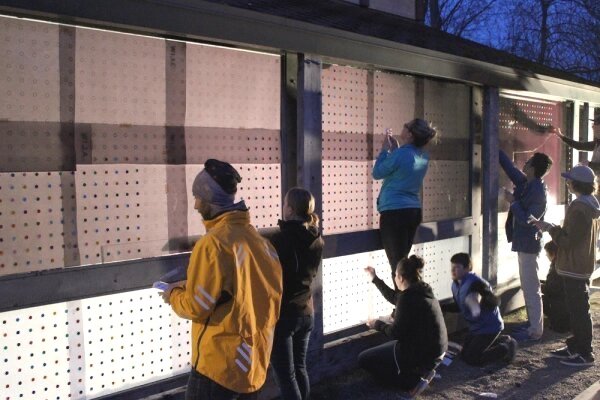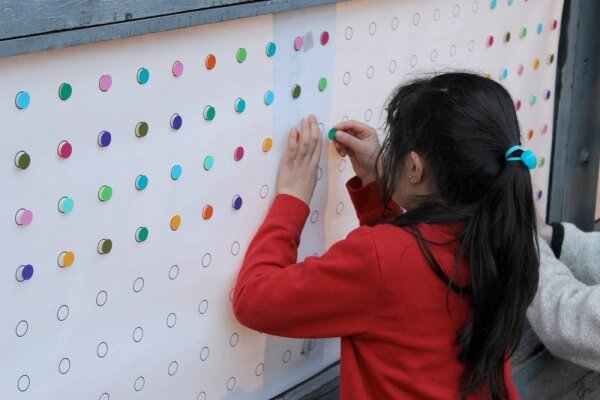The Department of Bird Safety is interested in producing socially engaged art that raises awareness about issues concerning endemic and migratory birds. We intend to engage and empower the community through a number of activities, including guided walks through local Vancouver neighborhoods that focus on birds and their habitats. We will also conduct workshops about art and how it can help people gain a greater understanding of our local ecology. We anticipate that through a program of research, outreach, and education, that people will start to take into account non-human uses of the city.’
Seeing Spots: Department of Bird Safety, Vinyl dots on window, 9 ft x 30 ft, 2015
Seeing Spots went up at the West Point Grey Community Centre on Wednesday (March 4, 2015). During the evening workshop, community members and their children helped artists place almost 4,000 vinyl stickers—each a dot measuring 0.75 inches in diameter—on the windows of the main office.



Empathy/Expression: What I Saw When I Closed My Eyes and Hit My Head: Study for Deterrent (window), Oil on Canvas, 2018.
Seeing Spots with Pink Peripheral: Dept of Bird Safety, Oil, sparkles, and gaughe on canvas , 2023
Seeing Stars: Department of Bird Safety, Oil on canvas, 2020
Birds face various obstacles in the urban environment. Windows are considered to be one of the largest sources of direct human-caused mortality for birds in North America. Glass, whether reflective or clear, is effectively invisible to birds. They see it as a window onto a world. Birds collide with glass because they are trying to fly into the habitats they see beyond or reflected by the glass. According to the Vancouver Advisory Committee, in 2017 it was estimated that across Canada, 16-42 million birds are likely to be killed annually by collisions with buildings [1].
From experience, hitting something with your head, such as an unseen obstacle, makes you see spots. But what do these spots mean? Can they be seen as warnings? Are they just hallucinations? Can they ethically be seen as having an enjoyable aesthetic component; or do they just indicate bodily harm? In the case of the British artist Damien Hirst and in the light of negative opinion of some recent commentators, seeing spots has left this artist in the altered state of seeing dollars signs. In 2011, over 300 spot paintings existed, ranging in price from 7,000 to 25,000 euros, and have continued to increase in numbers and value since. In defence, Hirst has stressed these works aesthetic qualities stating that “to create that structure, to do those colours, and do nothing. I suddenly got what I wanted. It was just a way of pinning down the joy of colour” [2].
Historically, paintings have been considered windows onto a world and the painter’s goal was to portray depth and a sense of space beyond its surface. This view of painting is parallel to how birds currently perceive unobstructed windows in an urban environment. During the late modernism period of art production however, painters began to deconstruct, isolate and explore the diverse functions of painting, one of which was to draw attention to its surface through colour and flatness. Hirst’s work participates in this trajectory. The Department of Bird Safety’s goal however, is much different in that it hopes to adapt this line of thinking to support the evolution of bird perception into the modernist paradigm of flatness and to use the window/canvas as a space for the contemplation of consciousness, both human and non-human. To open up rather then pin down the potential of colour.
Article by Sue Palmer on the DBS
https://inquilines.com/2016/09/21/parks-art-the-bird-project-vancouver/




